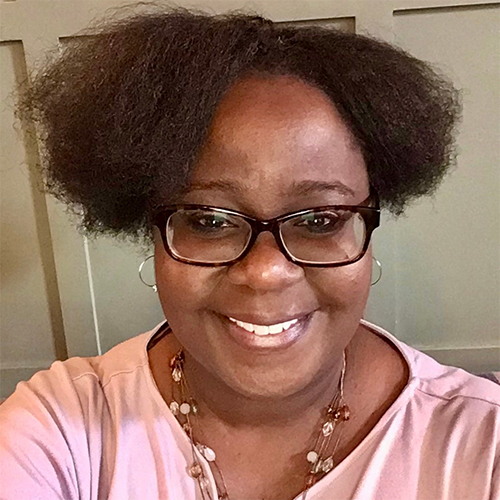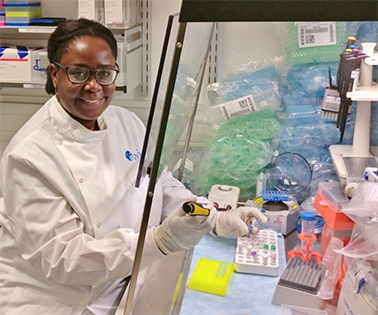May 11, 2022
Meet the IAVI scientist who developed a new HIV test for resource-limited settings
Dr. Catherine Namugga Kibirige, research associate, research team, IAVI Human Immunology Laboratory – Imperial College London
This test sensitively quantifies diverse strains of HIV to advance vaccine and cure research.

What is the focus of your work most recently?
The focus of my work has been creating molecular tools for either treatment monitoring, vaccine research, or cure research. I work in the IAVI Human Immunology Lab in London, and I’ve completed the development of an ultrasensitive quantification assay for HIV using RNA or DNA. I applied it to our vaccine screening protocol to provide an earlier readout. This assay is still in the testing phase and needs approval before it can be used but that’s something that’s in the pipeline.
What about your work is unique within the global health research and development landscape?
I’m focused on adapting research tools so that they capture the viral HIV strains in Africa. For this assay, we’re extending it so that we can detect other strains as well as the subtype B. This is critical to effectively carry out research in most areas of the world because subtype B only makes up 10% of global HIV subtypes. What inspires my work is adapting things so that they can be utilized in resource-poor settings, particularly in Africa. What’s really driving me right now is to develop the cheapest, simplest version of the assay. I think I have a unique background and a unique perspective that will allow me to accomplish this. We have the highest burden of disease. We have the greatest need, and we need things that we can use sustainably within our setting.
What do you hope your assay will accomplish for affected populations globally?
I’m really hoping that the assay will help improve access to testing and reduce the development of drug resistance in my home country of Uganda and other regions of Africa. I am also hoping that it can be used in cure research and can make that accessible to those with the greatest need in Africa and globally too. The great thing about working with IAVI is that I have access to different groups that I’m hoping to collaborate with to field test the assay, produce it, and generate data. And the great thing about being at Imperial College is that they have a good commercialization team. I’ve found a commercialization partner who’s willing to work with me and with my colleagues in Africa to field test and generate the data to prove its efficacy. The group in Uganda are already doing these kinds of test comparisons and are set up to field test the kits in their mobile clinics when they go into remote areas. So that’s what I really hope I’m able to accomplish with the assay.
In your scientific opinion, why is it so important to have access to HIV testing?
It’s important to have access to HIV testing because it’s the main way that we monitor the effectiveness of treatment. When people are successfully treated, the virus is undetectable in their [blood] plasma and they’re not spreading the virus to other people. Also, there’s a lot of emerging research showing that the longer you can stay properly suppressed, the more likely you are to become a good candidate for cure research. So, there are some people who’ve been on treatment for a very long time whose profiles look like they may have a functional cure. And the only way you know if the virus is suppressed this long is through testing.
What motivates you to get up every day and keep doing the work you are doing?
I’ve worked on this for such a long time, and it’s been a grueling and bumpy road. When I returned to Johns Hopkins University for my second postdoc in Baltimore, my previous advisor and I put together a proposal and got funding for more research on the assay. When you have ideas and get funded that really fuels you along. I think just having my eye on the prize and seeing how what I’m doing could apply to the issues back home is what has kept me in research. HIV has such a huge impact on Uganda and having worked out in Rakai, where HIV was first discovered in Africa, experiencing some of the difficulties and seeing what’s on the ground, seeing how dependent we are on external funding, understanding how much we need to become more self-reliant and self-sufficient, and have tools that are really viable for our setting continues to motivate me.

When I was in the US, I had this idea about how the assay could be adapted for resource-limited settings, but I couldn’t get anyone to buy into the idea. I noticed that they were more focused on subtype B and more interested in new technologies. So, when I got to IAVI, and they were willing to fund me to validate the assay and allowed me to do enterprise training, this really kept me going because I’m finally able to get my idea implemented.
A former colleague in Uganda heard me talking about the commercialization process and how we could get affordable ambient-temperature kits out to them. She was like, no, we want to have it actually manufactured here in Uganda. So, now she is the one motivating me to manufacture the assay in Uganda. It’s not even my idea, necessarily. It’s her saying, well, how do we manufacture it here?
It’s amazing that it all began with me volunteering in Rakai and now the person I plan to move this forward with is a colleague that I met at Johns Hopkins while doing our PhDs under the Ugandan Ministry of Health. It turns out that she has been mandated by Parliament to start manufacturing diagnostics and has been given some funding. So, when she saw my publication, she got in touch and said, well, how do we get a hold of your assay? It’s funny how our paths intertwined and how it all lined up in the end. It’s a lesson to never underestimate your network because we were both struggling to figure out our thesis topics and just navigate the system when we were in Baltimore. I remember she came with her daughter, and she used to get me to help her do her daughter’s hair. Several years ago, I was styling her and her daughter’s hair and now we are going to be learning how to manufacture diagnostics in Uganda together. It also speaks to the importance of educating and empowering women. I think it’s a wonderful end to the story.
So you plan to start supplying these tests to Uganda and other test sites, then possibly manufacturing them in Uganda as well, but once you see the benefits of the assay in Uganda what would be your next steps? What is your future vision for this assay? Could this test prove helpful for those in fragile or humanitarian settings, such as refugees or displaced peoples?
Yes indeed. I mean, the idea is to have it be kind of a lab in a box format eventually. One of the things that inspired me when I wrote the proposal that gave me the initial funding was this lab in a box concept that I’d seen at a conference. There was a group that had gone out to West Africa during the Ebola crisis, and they had a centrifuge that was rotor driven and a PCR instrument that ran on solar electricity. They developed a very easy diagnostic with color coded tubes. This group provided suitcases with everything clinical teams needed to go out into different remote villages and do their research or run their field clinics. So that’s what I had in mind. The whole idea is to be very simple and portable, that’s the vision for this assay.
What is one thing people would be surprised to know about you?
Well, I recently became involved in mental health advocacy because I have a mental health disability. I think when people first found that out, they were quite surprised. I’ve come a long way, but it’s been something that I’ve battled with since primary school, and then in my teenage years is when it became quite an acute issue. So, learning how to manage that and keep my science career going has been something I’ve grown through and learned a lot about.
I’m involved in advocacy, and I always speak up and try to encourage people and mentor people who are struggling with mental health, especially within the academic setting. I think it’s something particularly in the African community that we could do well with talking about more openly. In the beginning, it was very difficult for me to become more open, but I’m glad I have because I’ve realized that when you educate people, their attitudes do change and it’s very impactful for those who are struggling to be in a safer community and have more understanding and adjustments towards their mental health.